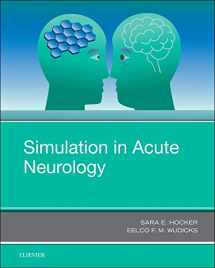
Simulation in Acute Neurology
ISBN-13:
9780323551342
ISBN-10:
0323551343
Edition:
1
Author:
Eelco F. M. Wijdicks M.D PhD FACP FNCS FANA, Sara E. Hocker M.D
Publication date:
2018
Publisher:
Elsevier
Format:
Hardcover
150 pages
Category:
Internal Medicine
,
Medicine
FREE US shipping
Book details
ISBN-13:
9780323551342
ISBN-10:
0323551343
Edition:
1
Author:
Eelco F. M. Wijdicks M.D PhD FACP FNCS FANA, Sara E. Hocker M.D
Publication date:
2018
Publisher:
Elsevier
Format:
Hardcover
150 pages
Category:
Internal Medicine
,
Medicine
Summary
Simulation in Acute Neurology (ISBN-13: 9780323551342 and ISBN-10: 0323551343), written by authors
Eelco F. M. Wijdicks M.D PhD FACP FNCS FANA, Sara E. Hocker M.D, was published by Elsevier in 2018.
With an overall rating of 4.5 stars, it's a notable title among other
Internal Medicine
(Medicine) books. You can easily purchase or rent Simulation in Acute Neurology (Hardcover) from BooksRun,
along with many other new and used
Internal Medicine
books
and textbooks.
And, if you're looking to sell your copy, our current buyback offer is $2.17.
Description
Simulation in Acute Neurology is a reference on the execution of a simulation-based educational program in the management of acute neurologic emergencies. Simulation in Acute Neurology has practical value because it contains detailed descriptions of our simulation scenarios. The foundation of this book is our experience with neurosimulation―and it has been a very good one. Part I provides an overview of the principles of simulation in medicine and examines the many unique opportunities simulation provides as an educational tool. Barriers to simulating neurologic emergencies are also discussed. Simulation allows a physician-in-training to be observed directly as he or she evaluates and manages acute neurologic disease. Part II is the core of the book. Fifteen acute neurologic emergencies, including complex neuroethical quandaries, are presented in detail, step by step, decision by decision, error after error. Each chapter in this section starts with an explanation of the essence of the discussed neuroemergency (THE PROBLEM BEFORE US), followed by a description of the scenario itself (THE PRESENTING CLINICAL PROBLEM), how scenarios can be adjusted to different types of learners (ADAPTING THE SCENARIO), and ends with a discussion of topics for feedback, which are generally focused around errors and pitfalls (DEBRIEFING). To show the flow of scenarios, we created two additional main headings: (THE IDEAL LEARNER) and (THE NOT-SO IDEAL LEARNER).


We would LOVE it if you could help us and other readers by reviewing the book
Book review

Congratulations! We have received your book review.
{user}
{createdAt}
by {truncated_author}


